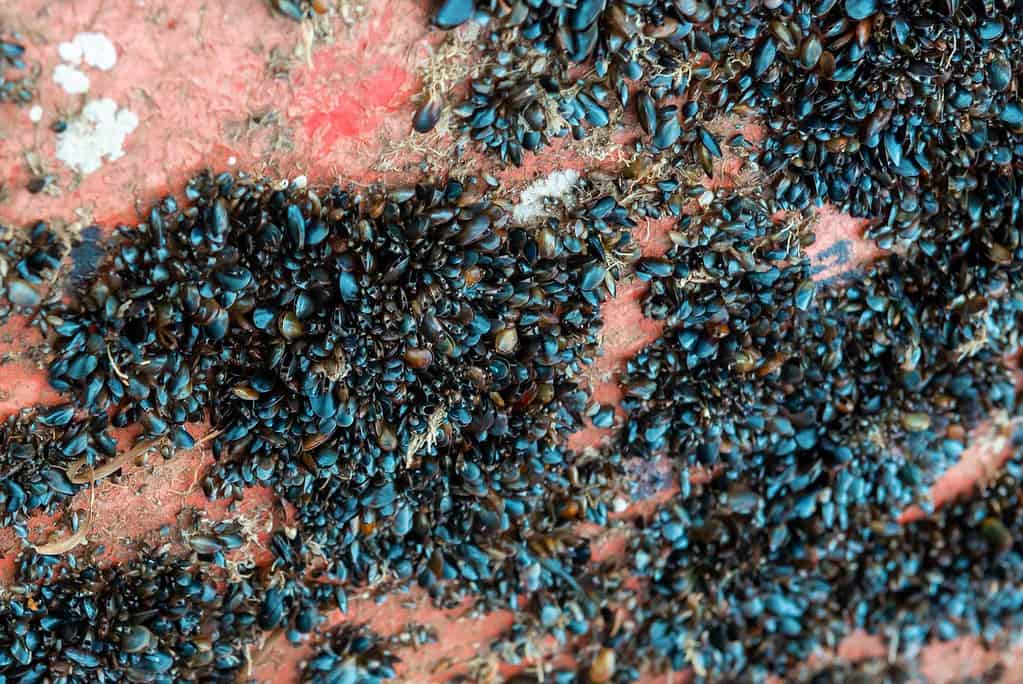There are many astonishing bodies of water on this planet. Some are natural, and some are man-made. One example of an impressive feat of humankind is the Richland-Chambers Reservoir.
The original purpose of this reservoir was to provide a water supply for the area. However, it has evolved into a well-loved lake that is not only practically useful but also a great recreational area. If you are wondering how deep is the Richland-Chambers Reservoir in Texas, the answer to this question is below!
Where Is the Richland-Chambers Reservoir?

In terms of big cities, it is 60 miles southeast of downtown Dallas.
©f11photo/Shutterstock.com
The Richland-Chambers Reservoir is located in the state of Texas, specifically in Freestone County and Navarro County. It is south of Kerens and east-southeast of Corsicana. In terms of big cities, it is 60 miles southeast of downtown Dallas. Interstate 45 runs north to south just slightly west of this body of water.
The impoundment of Chambers Creek and Richland Creek formed this reservoir. The dam is at the eastern end of the “Y” shaped reservoir, which has about 330 miles of shoreline. One arm of the “Y” stretches west, and the other stretches in the northwest direction.
How Deep Is the Richland-Chambers Reservoir?
The Richland-Chambers Reservoir is 75 feet deep at its deepest point, although the depth at any specific point can vary depending on the terrain upon which the reservoir was built.
The top of the conservation pool of this reservoir is located approximately 315 feet above sea level. The fluctuation range is about three feet around this level.
History of the Richland-Chambers Reservoir

The 90-inch pipeline between the reservoir and Lake Benbrook became operational in November 1988.
©Ricky Lynn Harris/Shutterstock.com
The Tarrant Regional Water District owns and operates the Richland-Chambers Reservoir. This reservoir exists for flood control, irrigation, water supply, and recreation purposes.
The original plans to build this reservoir were set in place after a drought in the 1950s. It was supposed to be a public water source for Tarrant County. However, no one took action until October 1979. This was when the water district issued $342.75 million in revenue bonds.
Construction of the dam began in October 1982, with the impoundment of water starting in July 1987. The reservoir was completed in November 1987, and it was filled up by May 1989. The 90-inch pipeline between the reservoir and Lake Benbrook became operational in November 1988.
The Tarrant Regional Water District owns most of the water rights to this reservoir, whose clarity is typically cloudy to moderately clear. The pipeline pumps the water from this reservoir to balancing reservoirs, as well as to Lake Benbrook for storage. It then moves to either Eagle Mountain Lake or water treatment plants.
Components of the Richland-Chambers Reservoir
Richland-Chambers Dam is an earthen embankment that is 6.5 miles long. At its tallest point, it stands at a height of 120 feet above the water. The spillway of the dam is located at Station 133, which is about one mile north of the original Richland Creek. This spillway is about 960 feet long, and 24 tainter gates control it.
What is the Surface Area of the Richland-Chambers Reservoir?
At the top of the conservation pool, this reservoir can hold 1,112,763 acre-feet of water. The surface area of this reservoir at this point is 43,384 acres. The reservoir allows a surcharge of two feet above the top; if the water is filled up to this point, the reservoir can hold a total of about 1,211,263 acre-feet of water, and the surface area will now be 45,500 acres.
The Richland-Chambers Reservoir is the eighth-largest reservoir in Texas by water volume and the third-largest inland reservoir by surface area.
Things to Do at the Richland-Chambers Reservoir
Even though the primary purpose of this reservoir has always been for water supply, it is also a popular recreational site. People like to go swimming, boating, and fishing here. There are numerous boat launch sites, as well as The Harbor Inn Restaurant & Club on the banks of the lake.
Since this reservoir is relatively new, the traffic level is generally low. There is also plenty of space available for lakeside housing.
Fishing in the Richland-Chambers Reservoir

There is an abundance of Blue
Catfish
in the Richland-Chambers Rerervior.
©Billy Ogle/Flickr – License
The Richland-Chambers Reservoir is the perfect location for anglers. There is an abundance of crappie, blue and channel catfish, hybrid striped bass, and white bass. Locations with clear water and visible vegetation are great for finding largemouth bass, but these areas do not comprise a large proportion of the lake.
Smallmouth buffalo and carp are also among the predominant fish species in this reservoir. The lake has been deliberately stocked with Florida bass, blue catfish, channel catfish, and copper nose bluegill.
For about a decade after the construction of this reservoir, largemouth bass tournaments were common, with many basses caught around 35 pounds. However, multiple droughts have since diminished the average size of these catches. This reservoir is no longer a top lake for bass fishing.
A common strategy among anglers is to set up a jug line for catfish and then go after bass. This reservoir might be the most consistent source of black and white crappie in the area.
An Invasive Species in the Richland-Chambers Reservoir

Zebra mussels
have invaded the Richland-Chambers Reservoir.
©Dolores M. Harvey/Shutterstock.com
Currently, zebra mussels have invaded the Richland-Chambers Reservoir. Zebra mussels are native to Eurasian waters, specifically those of Russia and Ukraine. It is a mollusk that is typically about the size of a human fingernail, although the largest one can be about two inches in length. Each one has a pattern of dark stripes on its shell, which gives the animal its name.
Zebra mussels have multiple negative impacts on ecosystems. They are filter feeders and end up filtering out algae that native species typically feed on. They also incapacitate native mussel species and clog up water intakes. In addition, the waste they produce ends up on the lake floor and can interact with sunlight to form cladophora, a species of algae that can be a nuisance.
In order to help prevent the spread of zebra mussels, anyone boating in the Richland-Chambers Reservoir needs to make sure to thoroughly clean, drain, and dry their boats, trailers, and all equipment before moving the boat to another body of water. Otherwise, zebra mussels that latch onto these materials can spread and multiply elsewhere.
Where is Richland-Chambers Reservoir on a Map?
In Texas, the Richland-Chambers Reservoir ranks as the third-largest inland reservoir in terms of surface area and the eighth-largest in terms of water volume. It is created by containing the waters of Richland Creek and Chambers Creek, located to the east-southeast of Corsicana and south of Kerens in Navarro County and Freestone County, Texas, USA.
Here is Richland-Chambers Reservoir on a map:
The photo featured at the top of this post is © Floridian/Shutterstock.com
Thank you for reading! Have some feedback for us? Contact the AZ Animals editorial team.






